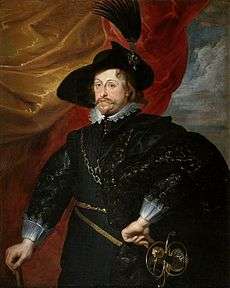Lithuanian Naval Force
The Lithuanian Navy (Lithuanian: Lietuvos Karinės jūrų pajėgos) is the naval arm of the Lithuanian Armed Forces. Though formally established on 1 August 1935 its roots stretch back as far as naval engagements on the Baltic Sea in the Medieval period. Lithuanian naval units saw some service with Soviet naval forces during World War II, and the navy has been re-established in its own right and continues to expand since Lithuania's independence in 1990.
| Lithuanian Naval Force | |
|---|---|
| Lietuvos Karinės jūrų pajėgos | |
 Insignia of the Lithuanian Naval Force | |
| Active | First armed ships in IXc. 24 March 1568 (Sea Commission) 1626 (Commission of Royal Ships) 1935–1939, 1992 - present |
| Country | |
| Type | Navy |
| Role | Control, protect and defend territorial sea and exclusive economic zone. |
| Part of | Lithuanian Armed Forces |
| Garrison/HQ | Naujoji uosto 24, LT-92244 Klaipėda |
| Anniversaries | 1 September 1935 4 July 1992 |
| Commanders | |
| Commander in Chief | Flotilla admiral Arūnas Mockus |
| Insignia | |
| Naval ensign | 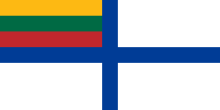 |
| Naval jack | .svg.png) |
History
Intro
Although the origin of the Lithuanian Navy dates back to the period between World War I and World War II, the history of the involvement in naval battles existed earlier. The Baltic tribe of Aistians that settled down in the Baltic Sea shore built ships and used them for trade as well as for military purposes. Furthermore, according to annals, in the 13th century other Baltic tribes, the Coronians and Samogitians, tried to destroy the castle of Riga coming by ships. It is also known about the Lithuanians’ victory in the ship battle in Nemunas River at the time when Duke Vytenis ruled the Duchy of Lithuania. The most known and important naval victory was achieved by great hetman Jan Karol Chodkiewicz on 24 March 1609 near Salismünde (now Salacgrīva in Latvia) where he defeated a Swedish fleet burning two enemy ships and losing none and hence breaking the blockade of Riga city. But generally the loss of territories near the Baltic Sea had a negative impact on Lithuania's maritime development.
Coronians-Baltic Pirates 1-13th century
Samogitians and Coronians attacking Riga Castle coming with Ships
Samogitian and Lithuanian River Battles with Crusaders
The first LDK sea Battle
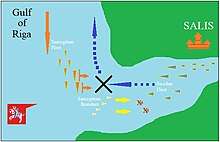
The naval Battle of Salis took place during the Polish–Swedish War (1600–1611) during the night of March 23–24, 1609. After the capture of Pärnu, Jan Karol Chodkiewicz, commander of the Lithuanian army, moved towards Riga, which was occupied by the Swedes under the command of Joachim Frederick von Mansfeld. Along the way, Chodkiewicz saw a chance to destroy the Swedish squadron based in the Salis port which blocked Riga. The dominant presence of the Swedes in the Baltic region gave the Lithuanian army the upper hand, as von Mansfeld and the Swedish army did not expect the possibility of an attack in such a heavily Swedish-occupied region.
Chodkiewicz's army consisted of two Cog ships obtained in Pärnu, filled with Samogitians infantry and armed with cannons brought in from Pärnu castle. The squadron was additionally reinforced by a few hastily armed merchant ships (probably five) purchased from the English and Dutch sailors, and a couple of boats and bateaux. To assist in managing vessel traffic, Chodkiewicz hired a few sailors, mainly Livonian.
On the night of March 23, Chodkiewicz's army (consisting of Samogitians, Livonians, and probably some bribed members of the Swedish infantry) surprise-attacked the Swedish fleet. Using the favourable winds blowing inland, Chodkiewicz sent several (probably four) fire ships (their first use in the Baltic in modern times) into the port, setting several ships on fire and pushing them in the direction of the Swedish warships anchored in formation.
Unprepared for the attack, the Swedish attempted to save their ships by cutting their anchor ropes and to flee. Despite this, two Swedish ships were burned and soon sank. Retreating from the port, the Swedish unit came under fire by Samogitians ships waiting at the roadstead. Chodkiewicz's Swedish squadron did not attempt to engage in an artillery fight and immediately escaped to the waters of the Gulf of Riga. Samogitians units, slower than the Swedish ships, did not attempt to pursue them. The entire Port of Salis, together with stocks of weapons, ammunition and food, fell into the hands of the Samogitians. The victory of Pärnu and Salis had a direct impact on the further course of the war and contributed to halting the Swedish assault on Riga.
Origins
Polish–Lithuanian Commonwealth Navy
The Commonwealth Navy was small and played a relatively minor role in the history of the Commonwealth.[1] Despite having access to the Baltic Sea, neither Poland nor Lithuania had any significant navy throughout their histories.
Vasa's plans for fleet creation
At the turn of the seventeenth century, Poland became ruled by the House of Vasa, and was involved in a series of wars with Sweden (see also dominium maris baltici).[1] Vasa kings attempted to create a proper fleet, but their attempts met with repeated failures, due to lack of funds in the royal treasury (Polish nobility saw little need for the fleet and refused to raise taxes for its construction, and Gdańsk continued its opposition to the idea of a royal fleet).[1] During the reign of Sigismund III, the most celebrated victory of the Commonwealth Navy under command of Admiral Arend Dickmann took place at the Battle of Oliwa in 1627 against Sweden, during the Polish-Swedish War. The victory over Sweden secured for Poland permanent access to the Atlantic, and laid the foundations for expeditions beyond Europe. The plans for the independent fleet fell through shortly afterwards due to a badly executed alliance with the Habsburgs who in 1629 took over the fleet.[1]
The Commission of Royal Ships (Komisja Okrętów Królewskich) was created in 1625. This commission, along with the ultimate allocation of funds by the Sejm in 1637, attempted to create a permanent Commonwealth Navy. Władysław IV Waza who took the throne in 1632 bought 12 ships, and built a dedicated port for the royal navy (Władysławowo).[1]
Władysław IV and plans for Navy expansion
The 58th article signed and sworn by king Władysław IV Pacta conventa announced creation of a war fleet "according to needs of Commonwealth". Władysław, taking the throne after his father Sigismund III Vasa died in 1632, was in favour of expanding and modernising the Commonwealth military. One of his plans was the expansion of the Commonwealth Navy.
Despite his attempts he did not recover ships taken by Swedes in Wismar and Travemuende. Władysław decided to build a new fleet and created a "Naval Commission" with Gerard Denhoff as a chairman to fulfill this task. The choice of other members of this Commission was not random, it contained wealthy king supporters, like the merchant and owner of a merchant fleet from Danzig, Georg Hewel (Gdańsk, Jerzy Hewel). Because the Sejm (Polish Diet) was at best reluctant to pay for new ships and royal chest was permanently empty it was due to Hewel that the new fleet was created at all. He gave to the king's disposal 10 ships, a few of them were carrying small caliber cannons. These ships had to be modernized in order to allow them to carry heavier cannons. Additionally the king wanted to build a few galleons in Danzig and Puck and because of long construction times, also to purchase a few ships abroad, but those plans were not realized (except of purchase of one Danish ship - requiring quite serious repair).
Thus the new 'Polish fleet' consisted of 10 ex-merchant ships: "Czarny Orzeł" (Black Eagle – 420 tons, 32 cannons), "Prorok Samuel" (Prophet Samuel – 400 tons, 24 cannons), "Wielkie Słońce" (Great Sun – 540 tons, 24 cannons), "Nowy Czarny Orzeł" (New Black Eagle – 24 cannons). Four smaller ships "Biały Orzeł" (White Eagle), "Charitas", "Gwiazda" (Star) and "Strzelec" (Saggitarius) had 200 tons and two the smallest "Święty Piotr" (Saint Peter) or "Fortuna" (Fortune) 160 tons and "Mały Biały Orzeł" (Small White Eagle) 140 tons and 4 small caliber cannons and additionally one small galley. Command of the newly created fleet was given to rear admiral Aleksander Seton.
The King did not forget to ensure a safe base for the newly created fleet. The Harbor in Puck was too shallow for the biggest ships and the usage of Wisłoujście (a fortress near Gdansk) was constantly plagued by difficulties from the Danzig Patricians (afraid that a king with a strong naval arm would step upon their "liberties", control tolls, exert taxes etc.). The royal engineers Friederich Getkant (Fryderyk Getkant), Jan Pleitner and Eliasz Arciszewski selected a location for two new fortifications with naval bases on the Hel peninsula. They were quite impressive and raised in record time (finished in 1634, consisting of strong wooden (oak) palisades, earthen walls, trenches and moats). These fortifications were named after the King and his brother: Władysławowo and Kazimierzowo (the small town of Władysławowo still exists on the Hel peninsula nowadays - the fort was more or less on its current edge).
Additionally about 500 Cossacks under Konstanty Kołek with their small boats (Chaika) were brought. It is uncertain if they were used at all.[2] Their main goal was to plague Swedish communication and supply lines near Piława and on Zatoka Wiślana (Vistula Bay). There were plans to use Cossacks in their light but very fast boats against Inflanty (Livonia) and even to raid the Swedish shore (to burn, pillage, capture merchant ships etc.). Cossacks were known from their plundering raids on Black Sea (they even burned suburbs of Istanbul once or twice). Because of the overall tonnage and armament difference between Polish and Swedish naval fleets even before (in 1620s), the main role of the Polish fleet was to disrupt Swedish communication and supply lines, to capture merchant ships bringing supplies for the Swedes (even if they belonged to neutral powers, for example ships belonging to the Netherlands, England or German duchies/cities were captured and sequestrated).
The king's plan never had strong support from Polish nobles (szlachta): high costs and reluctance to strengthen the king's power were always crippling Władysław's plans. Thus not even all the king's expenses for the modernization of those ten ships were fully repaid. Unfortunate international alliances (with Denmark and Muscovy) did not allow him to mount any offensive actions and the majority of the wars he participated in were defensive ones (like the Smolensk War with Muscovy in 1634). A new armistice with Sweden signed in Stumsdorf (Sztumska Wies) knocked the last argument out of the king's hand. After that the king wanted to use his ships to organize the first Polish merchant company (with help of Hewel), however Hewel's death stopped even those plans. Finally the ships were sold. The built fortifications were salt in Denmark's and the Danzig Patriciate eyes and under their pressure were destroyed in 1640s.
The Swedes were without king after the death of Gustavus Adolphus of Sweden and lost battles in Germany. The Polish nobles did not want to fight a new war so when the Swedes returned most of the lands they captured in the previous war, a new armistice for 35 years was signed. The cost of the Polish preparations for this war was comparable with the costs of the king's relief of Smolensk in 1634 and his campaign against Muscovy.
Commonwealth fleet after 1630s
The fleet was destroyed in 1637 by Denmark, without declaration of war.[3]
The remaining ships were sold in the years 1641-1643, which marked the end of the Commonwealth Navy.[1]
Ships of the Polish–Lithuanian Commonwealth Navy
- Ritter Sankt Georg (Rycerz Święty Jerzy) ("Knight St George") – galleon, 31 guns, 400t under the command of Johann Storch
- Fliegender Hirsch (Latający Jeleń) ("Flying Deer") – galleon, 20 guns, 300t under the command of Ellert Appelman
- Meerweib (Panna Wodna) ("Sea Virgo") – 12 guns, 160t under the command of Adolf von Arzen
- Schwarzer Rabe (Czarny Kruk) ("Black Raven") – 16 guns, 260t under the command of Alexander Bley
- Gelber Löwe (Żółty Lew) ("Yellow Lion") – 10 guns, 120t under the command of Hans Kizer
- Meermann (Wodnik) ("Aquarius") – galleon, 17 guns, 200t under the command of Hermann Witte
- König David (Król Dawid) ("King David") – galleon, 31 guns, 400t, under James Murray (known to the Poles as Jakub Mora)
- Arche Noah (Arka Noego) ("Noah's Ark") – 16 guns, 180t under the command of Magnus Wesman
- Weißer Löwe (Biały Lew) ("White Lion") – 8 guns, 200t under the command of Peter Böse
- Feuerblase (Płomień) ("Fireblaze") – 18 guns, 240t
Independent Navy 1935-1939
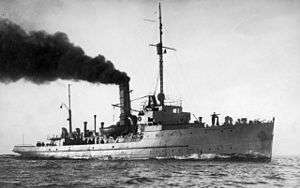
After World War I, the Government of Lithuania attempted to establish a maritime defense force. However, due to various political and economical reasons, the maritime defense force was only partially implemented. In 1923, Lithuania gained the control of Klaipėda harbor[4] and gradual development of the maritime defense force started. The purchase of a minesweeper in 1927 was one of the first significant steps to implement Lithuanian Government aims. The ship was commissioned as the training ship Prezidentas Smetona (President Smetona). Captain Antanas Kaskelis was assigned as ship's commanding officer. Several small boats carried out patrol duties(Coast Guard 3-6 cutter) and one small yacht in Klaipėda harbor. Naval officers were educated abroad. On 1 August 1935, the commander in chief of the Lithuanian Armed Forces, General Stasys Rastikis, officially established the Lithuanian Navy as a branch of the Lithuanian Armed Forces.
The impact of World War II
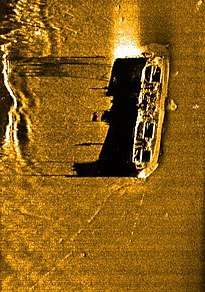
Before the beginning of World War II on 22 March 1939 the region of Klaipėda was occupied by Germany.[5] Once the war started Lithuanian naval ships were forced to leave Klaipėda for Liepāja harbor in Latvia. During the Soviet occupation, 3 Russian boats blocked ship Prezidentas Smetona in Sventoji harbor (1940). The Lithuanian Navy was attached to the Soviet Union's Baltic maritime defense force. Prezidentas Smetona was renamed Korall and participated in the sea battles against Nazi Germany's Kriegsmarine. On 11 January 1945, the ship triggered a mine and sank in the Gulf of Finland.
Restored Navy after the declaration of independence 1992-2006
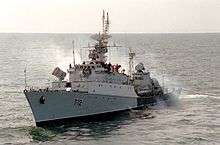
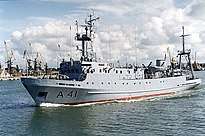
After the declaration of independence on 11 March 1990, Lithuania had to re-establish its sovereignty as well as organize the state's defense system, which formed the Lithuanian Armed Forces. On 4 July 1992 the Lithuanian Navy was re-established. Juozapas Algis Leisis was appointed as commander of the Coast Guard Squadron.
The first commissioned ship in the Lithuanian Navy was the A41 Vėtra. Vėtra belongs to the Klaipeda harbour administratiion.The Vėtra is used for SAR and supply operations. In1992, the Lithuanian Navy received two Grisha-class corvette, Zemaitis (F11) and Aukstaitis (F12) from Russia. After the crew training period in June 1992 both corvettes participated in the international military exercise US Baltops 93. This marked the beginning of Lithuanian cooperation with international navies.
In the period spanning 1992-2000 the Lithuanian Navy received 3 Storm-class patrol ships from Norway, two Lindau-class mine-hunters from Germany, a cutter(ex-Vilnele 1983) from the Klaipeda harbor administration, and a tug and dive cutter Lokys from Sweden.
Another milestone in Lithuanian naval history was the establishment of the Sea Coastal Surveillance Company in 1993 which was then transformed into the Sea Coastal Surveillance Service. On 1 April 2004, Lithuania became an official member of the NATO alliance. Currently the Lithuanian naval forces are undergoing rapid modernization.
Modern Lithuanian Navy from 2006


In 2006 Lithuanian Navy received Ex-HNoMS Vidar (N52) from the Royal Norwegian Navy. The navy used Jotvingis (N42) as a command-and-supply ship. Vetra was later decommissioned and scrapped. Jotvingis took part with the Air Defence Forces exercises, being used as a launch platform for the RT-400 SAM missile.
In the period spanning 2008-2016 the Navy bought 4 Flyvefisken-class patrol ships from Denmark which received the names P11 Žemaitis, P12 Dzūkas, P14 Aukštaitis, and P15 Sėlis. This led to the decommissioning and later scrapping of the Grisha-class corvettes.
The Navy received Šakiai which was transferred from the Klaipeda harbour administration In 2013 the Navy commissioned ex-HMS Cottesmore and ex-HMS Dulverton. The vessels received the names M53 Skalvis and M54 Kuršis. Both are used in the Mine Countermeasures Squadron.
Function

Main tasks of the Lithuanian Naval Force are:
- Control, protect and defend territorial sea and exclusive economic zone of the Republic of Lithuania.
- Underwater, surface surveillance and control of territorial waters.
- Mine-clearing operations.
- Anti-terrorism activities at sea.
- Protection and control of shipping and sea line of communications.
- SAR operations.
Fleet
Current
| Name | Picture | Origin | Class | Type | Built | Entered service (LNF) | Notes |
|---|---|---|---|---|---|---|---|
| Mine Countermeasures Squadron | |||||||
| N42 Jotvingis | 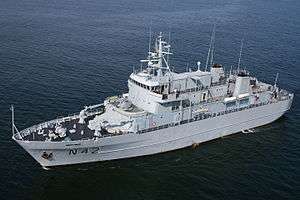 |
Vidar-class minelayer | Minelayer and command vessel | 1977 | 2006 | Command and support ship.[6] Former HNoMS Vidar (N52) of the Royal Norwegian Navy. | |
| M52 Sūduvis |  |
Lindau-class minehunter | Minehunter | 1958 | 2000 | Former M 1071 Koblenz in active service | |
| M53 Skalvis | Hunt-class mine countermeasures vessel | Mine warfare vessel | 1982 | 2011 | Officially commissioned 2013 May 18. Ex-HMS Cottesmore | ||
| M54 Kuršis | Hunt-class mine countermeasures vessel | Mine warfare vessel | 1982 | 2011 | Officially commissioned 2013 May 18. Ex-HMS Dulverton | ||
| Patrol Ships Squadron | |||||||
| P11 Žemaitis |  |
Flyvefisken-class patrol vessel | Multirole warship | 1985 | 2008 | ||
| P12 Dzūkas |  |
Flyvefisken-class patrol vessel | Multirole warship | 1988 | 2009 | ||
| P14 Aukštaitis |  |
Flyvefisken-class patrol vessel | Multirole warship | 1993 | 2010 | ||
| P15 Sėlis |  |
Flyvefisken-class patrol vessel | Multirole warship | 1988 | 2016 | Transferred from Danish Navy in 2016 | |
| Auxiliary Ships Squadron | |||||||
| PGL Šakiai |  |
SAR ship | 1986 | 2009 | |||
| H21 Vilnelė |  |
Cutter | 1983 | 1992 | Support vessel | ||
| H22 Atlas |  |
Tugboat | 1955 | 2000 | Can be used in an icebreaker role | ||
Retired
| Name | Picture | Origin | Class | Type | Built | Entered service (LNF) | Left service (LNF) | Notes |
|---|---|---|---|---|---|---|---|---|
| H23 Lokys |  |
Cutter | 1941 | 2005 | 2017 | Former diving boat | ||
| P32 Selis |  |
Storm-class patrol boat | Fast patrol boat | 1967 | 2001 | 2016 | ||
| M51 Kuršis |  |
Lindau-class minehunter | Minehunter | 1957 | 2000 | 2014 | Former M 1080 Marburg | |
| P33 Skalvis |  |
Storm-class patrol boat | Fast patrol boat | 1967 | 2001 | 2011[7] | Former P969 HNoMS Steil | |
| F12 Aukštaitis | .jpg) |
Grisha III-class corvette | Corvette | 1980 | 1992 | 2010[8] | Former MPK-44. Was scrapped after decommissioning. | |
| F11 Žemaitis |  |
Grisha III-class corvette | Corvette | 1981 | 1992 | 2008 | Former MPK-108 (Komsomolets Latviy). Was scrapped after decommissioning. | |
| A41 Vetra |  |
Valerian Uryvayev-class weather reporting ship | Support ship | 1977 | 1992 | 2007 | Former Rudolf Samoylovich. Was scrapped after decommissioning. | |
| P31 Dzūkas |  |
Storm-class patrol boat | Fast patrol boat | 1967 | 1995 | 2007 | Former P965 HNoMS Kjekk | |
Ranks and insignia
Officers
The rank insignia for commissioned officers for the navy.
| NATO code | OF-10 | OF-9 | OF-8 | OF-7 | OF-6 | OF-5 | OF-4 | OF-3 | OF-2 | OF-1 | OF(D) | Student officer | ||||||||||||||||||||||||
|---|---|---|---|---|---|---|---|---|---|---|---|---|---|---|---|---|---|---|---|---|---|---|---|---|---|---|---|---|---|---|---|---|---|---|---|---|
| General officers (Generolai) | Senior officers (Vyresnieji karininkai) | Junior officers (Jaunesnieji karininkai) | ||||||||||||||||||||||||||||||||||
(Edit) |
No equivalent |
 |
 |
 |
 |
 |
 |
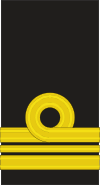 |
 |
 |
No equivalent |  | ||||||||||||||||||||||||
| Viceadmirolas | Kontradmirolas | Flotilės admirolas | Jūrų kapitonas | Komandoras | Komandoras leitenantas | Kapitonas leitenantas | Vyresnysis leitenantas | Leitenantas | Kariūnas | |||||||||||||||||||||||||||
| Limitation (as of 2012)[10] |
< 9 | < 30 | < 127 | < 375 | N/A | |||||||||||||||||||||||||||||||
| NATO code | OF-10 | OF-9 | OF-8 | OF-7 | OF-6 | OF-5 | OF-4 | OF-3 | OF-2 | OF-1 | OF(D) | Student officer | ||||||||||||||||||||||||
Enlisted
The rank insignia for enlisted personnel for the navy.
References
- Juliusz Bardach, Boguslaw Lesnodorski, and Michal Pietrzak, Historia panstwa i prawa polskiego (Warsaw: Paristwowe Wydawnictwo Naukowe, 1987, p.231
- Some sources state that the Cossacks were used; others, that they didn't arrive before the armistice.
- Michael Roberts (27 April 1984). The Swedish Imperial Experience 1560-1718. Cambridge University Press. pp. 16–17. ISBN 978-0-521-27889-8. Retrieved 7 June 2011.
- "Klaipeda State Seaport". World Port Source. Retrieved 2014-03-23.
- "The impact of the World War II on Lithuanian Navy". Ministry of National Defence Republic of Lithuania. Retrieved 2014-03-23.
- "Ministry of National Defence Republic of Lithuania". Retrieved 14 December 2014.
- "Lietuvos kariuomenė :: Kariuomenės struktūra » Karinės jūrų pajėgos » Aktualijos". Retrieved 14 December 2014.
- "Lietuvos kariuomenė :: Kariuomenės struktūra » Karinės jūrų pajėgos » Aktualijos". Retrieved 14 December 2014.
- (in Lithuanian) Principinės kariuomenės struktūros 2012 metais, planuojamos principinės kariuomenės struktūros 2017 metais nustatymo, krašto apsaugos sistemos karių ribinių skaičių ir statutinių valstybės tarnautojų ribinio skaičiaus 2012 metais ir 2017 metais patvirtinimo įstatymas
External links

- Lithuanian Naval Force official webpage
